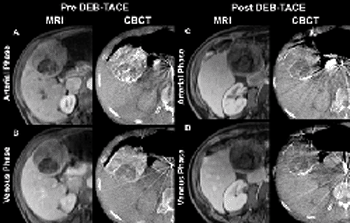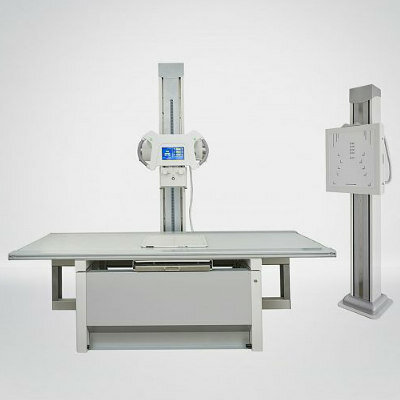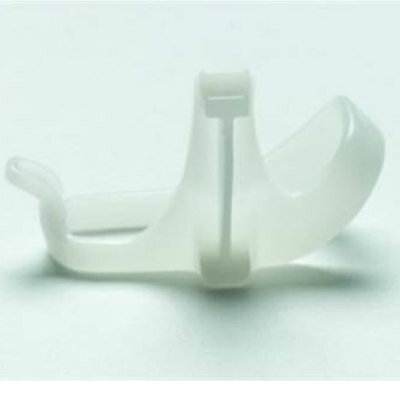Dual-Phase, Cone-Beam CT Scans Capturing Real-Time Images of Dying Liver Tumors
By MedImaging International staff writers
Posted on 15 Jan 2013
With the use of two consecutive pairs of specialized CT scans, a team of American and Dutch radiologists has generated real-time images of liver tumors dying from direct injection of anticancer drugs into the lesions and their surrounding blood vessels. Posted on 15 Jan 2013
Within one minute, the images revealed whether the targeted chemotherapy did or did not block off the tumors’ blood supply and saved patients one month of apprehension about whether the treatment, known as chemoembolization, was working or not, and if repeat or more powerful treatments were required.

Image: Specialized DPCBCT scans of a liver tumor in a 73-year-old man before and after chemoembolization (second and fourth column from left) match up closely with MRI scans taken over a month later (first and third columns) (Photo courtesy of Johns Hopkins University).
This innovative utilization of dual-phase cone-beam computed tomography (DPCBCT), an imaging technique, was developed at Johns Hopkins University (Baltimore, MD, USA), and was published in the January 2013 edition of the journal Radiology. The diagnostic scans were performed on 27 men and women with inoperable liver cancer.
“This new scanning method is giving us almost instant feedback about the value of injecting antitumor drugs directly into large liver tumors and their surrounding blood vessels in an effort to quickly kill them, and to prevent the cancer from spreading,” said senior study investigator and interventional radiologist Jean-Francois Geschwind, MD.
Dr. Geschwind noted that if additional testing proves to be equally effective, the paired use of cone-beam CT scans, which are already approved for single-scan use by the US Food and Drug Administration (FDA), could supersede the current practice of magnetic resonance imaging (MRI) scanning one month after chemoembolization to monitor its effects.
“Patients should not have to endure the uncertainty of waiting weeks or more to find out if their chemoembolization was successful in fighting their liver cancer,” stated Dr. Geschwind, a professor in the department of radiology at the Johns Hopkins University School of Medicine and its Kimmel Cancer Center. “Dual-phase cone-beam CT avoids such delays, which also could allow the cancer to grow and spread and, ultimately, compromise chances of remission.”
Avoiding delays is particularly important, he says, for people with moderate to advanced stages of the disease, when liver tumors are too large or too numerous to surgically remove, and for whom chemoembolization is the main treatment option. Half of such liver cancer patients succumb within nine months, and liver transplantation is only an option for a quarter of those whose tumors have not spread outside the liver. The newer DPCBCT scans, in which X-rays are detected by a device the size of a large laptop that can be positioned directly below or above the operating room (OR) table, have the added benefit of being performed in the same room, or interventional radiology room, as patients getting chemoembolization.
In their new study, Dr. Geschwind and his coworkers discovered that the first shrinkage seen with DPCBCT scans taken before and after chemoembolization matched up almost perfectly with MRI scans taken a month later. Tumor death was 95%, the same as that seen by MRI scans. A total of 47 tumors were closely monitored in the study to assess how well DPCBCT tracked tumor death after chemoembolization.
All study participants were treated at The Johns Hopkins Hospital between March and December 2009. In DPCBCT scanning, a contrast imaging dye is injected into the artery that supplies blood flow to the liver and tumor immediately before the chemotherapy drug is injected, to enhance the X-ray image. The first series of scans highlights the major blood vessels nourishing the tumor, as dye flows in and out of the tumor. The second set of scans is performed immediately after chemoembolization, to assess tumor and key blood vessel death. Computer software is used to sharpen and study discrepancies between the images.
The complete DPCBCT scanning time, according to the investigators, is between 20 seconds and 30 seconds, and the total amount of radiation exposure from the dual scanning averages 3.08 milliseiverts, which is less than half the amount of radiation involved in a modern abdominal 64-CT scan. Cone-beam CT scanners also emit X-ray radiation, but unlike other CT scanners, the cone-beam type of X-ray is projected onto one large, rectangular detector, about one and a half foot long--and produces a hallmark conical shape. The size of the cone-beam CT detector allows for single scans that can capture images the size of most people’s entire liver. More powerful 64- slice CT and 320-slice CT scanners involve multiple detector rows.
Chemoembolization involves the use of tiny beads containing the chemotherapy agent doxorubicin injected directly into liver tumors. Ultrathin catheters, about the width of a human hair, are threaded through blood vessels to deliver the drugs, which leak from the beads for several weeks.
Dr. Geschwind is leading clinical trials ongoing at Johns Hopkins and other centers to assess whether the drug treatment combo works for liver cancer patients. Preliminary findings have shown potential, with patients with advanced disease living 10 months to 15 months longer. According to Dr. Geschwind, they plan enhancements in image quality in DPCBCT scans, hoping additional modifications will encourage physicians to adopt the technique. They also plan updates to the navigational software that, such as a global positioning system (GPS), can track blood vessels feeding each tumor, and provide more precise and greater numbers of targets.
Liver cancer kills nearly 20,000 Americans each year, and is much more prevalent outside the United States, where it is among the top three causes of cancer death in the world. Specialists mention the rising numbers of hepatitis C infections, which cause chronic liver inflammation and are a leading risk factor for liver cancer.
The chemoembolization research study was funded by Bayer HealthCare (Leverkusen, Germany) and Onyx Pharmaceuticals (South San Francisco, CA, USA), manufacturer of sorafenib, and Biocompatibles, manufacturer of the microbeads.
Related Links:
Johns Hopkins University














